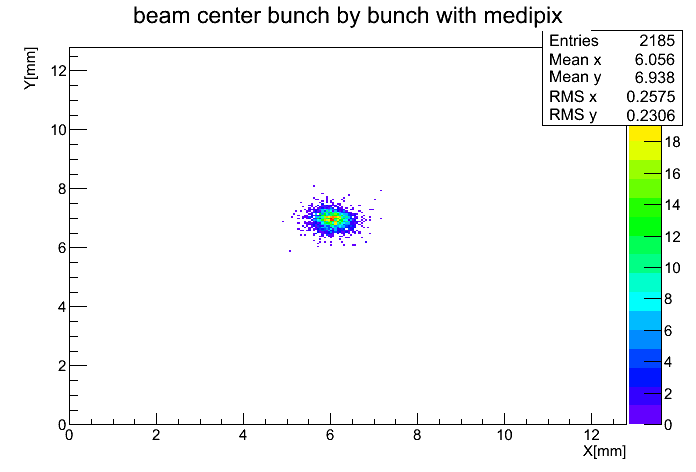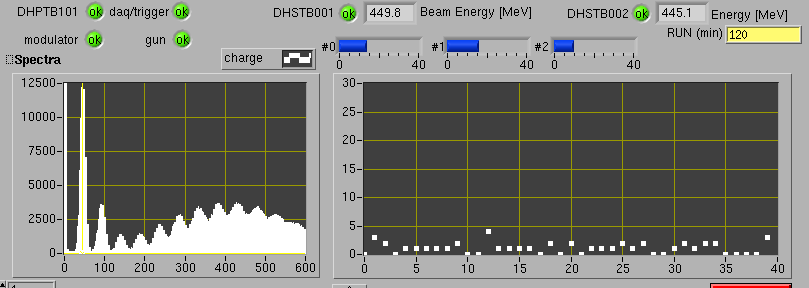THE DAΦNE BEAM TEST FACILITY
The BTF is part of the DAΦNE accelerator complex: it is composed by a dedicated transfer line, driven by a pulsed magnet, that allows to divert electrons or positrons (normally released to the DAΦNE damping ring) from the end of the high intensity LINAC (Table 1) toward an experimental area.
LINAC provides bunches composed on average of ~10^10 electron/bunch (or 10^9 positron/bunch). Each bunch has a fine structure derived from LINAC modulators that are driven with a ~2.85 [GHz] frequency. The LINAC bunch has up to ~34 microbunches (interbunch time 350[psec]).
The initial part of the transfer line delivers the LINAC beam to a copper converter with selectable radiation lenghts. The outgoing beam acquires a broaden energy spectrum down to few tens of MeV; the population per energy bin is determined mostly by the bremsstrahlung process. The remaining transfer line is composed of different dipoles, quadrupoles, correctors and couples of vertical and horizontal scrapers. These elements act formerly as energy, transverse parameters and multiplicity selectors. It is also possible to deliver directly the LINAC beam into the BTF area. The user can tune run-time the transfer line to cope the experimental needs.
The end of the transfer line is in a 100 m2 experimental hall, where detector calibrations and tests can be carried out. The facility, initially optimized to produce single electron in the 25-750(*) MeV energy range, can now provide beam with different particles in a wider range of intensity, i.e. up to 10^10(*) electrons/pulse [1]. Typical applications are high-energy detector calibration, low energy calorimetry, detector efficiency study, electronic equipment aging measurements, beam diagnostics device tests, etc.
Typical BTF Beam
LOW INTENSITY → BEAM MULTIPLICITY
Setup:
- Energy = 450MeV
- Multiplicity= 1.5(LINAC positron mode)-10(LINAC electron mode) part/bunch
- Detector = CALOBTF1 on BTFDAQ (V965)
- Timing = On LINAC TRG,
- Run = 3.84E7 secondary electrons
- Run Leader = BTFSTAFF
- Note = low resolution due to scattering material in front (~400um of multilayer Si detector). It is possible to understand the to different statistics in respect to the different primary particle beam.
LOW INTENSITY → BEAM PROFILE
Setup:
- Energy = 450MeV
- Multiplicity= 25 part/bunch
- Detector = Medipix
- Timing = On LINAC TRG,gate 200nsec
- Run = 3500 bunches
- Run Leader = Courtesy of Gabriele Chiodini
LOW INTENSITY → BEAM MEAN position stability
Setup:
- Energy = 450MeV
- Multiplicity= 25 part/bunch
- Detector = Medipix
- Timing = On LINAC TRG, rep rate =50Hz ,gate 200nsec
- Run = 3500 bunches
- Run Leader = Courtesy of Gabriele Chiodini

HIGH INTENSITY → MICROBUNCHED BEAM
Courtesy of AMY collaboration

(*) Dedicated time: from single electron mode to high multiplicity (full LINAC beam). These values can be obtained only when the BTF is operated without the DAΦNE main ring topping up. In this condition, the full intensity LINAC, needed for example for neutron production, can be transported and delivered into the BTF experimental hall. This kind of operation must be carefully scheduled with BTF staff.
The facility is operative an average of 250 days per year, day and night time, with users coming from Italy (about 50%) and all over the Europe.
LOW INTENSITY → TIMING
With DAFNE operations: the BTF timing has the following rules:
- 90 s switch time,
- 180 s min with 38 bunch/s non contiguous (primary electron beam),
- 90 s switch time,
- 180 s with 18 bunch/s non contiguous (primary positron beam),
- During the switch phase you will have 60 s without beam and 30 s with 49 bunch/s contiguous.
- Costing phase: this loop repeats until a DAFNE stop
- These rules are in dependance of the DAFNE needs, the average bunch rate will be lower in case of some DAFNE performance upgrades.
- In case of DAFNE stop, you will be switched to the LINAC-BTF phase, then 49 bunch/s contiguous.
- With this timing, the average will be 23 bunch/s.
- Conservatively, 20 bunch/s.
- We do not count in this average calculation, faults.
- Trigger rate is sub judice to the DAFNE requests, it is not possible to increase the average rate.
LOW INTENSITY → MULTIPLICITY TABLE
The BTF bunch rate is defined above, the interaction rate with your detectors is in dependance of the selected multiplicity:
Since the secondary beam multiplicity (particle in the single BTF beam bunch) follows a poissonian distribuition, in the so called "single particle operations" (with an λ poissonian parameter equal to 1) you will have about 36% of empty BTF bunches.
During positron LINAC phase, since the positron primary beam has less current, the λ factor of the secondary BTF beam is about 1/5 of the respective in the electron LINAC phase.
Poissonian Probability Table
λ = 0,1; 0,2; … 1,0
| k | 0,1 | 0,2 | 0,3 | 0,4 | 0,5 | 0,6 | 0,7 | 0,8 | 0,9 | 1,0 |
| 0 | .9048 | .8187 | .7408 | .6703 | .6065 | .5488 | .4966 | .4493 | .4066 | .3679 |
| 1 | .0905 | .1637 | .2222 | .2681 | .3033 | .3293 | .3476 | .3595 | .3659 | .3679 |
| 2 | .0045 | .0164 | .0333 | .0536 | .0758 | .0988 | .1217 | .1438 | .1647 | .1839 |
| 3 | .0002 | .0011 | .0033 | .0072 | .0126 | .0198 | .0254 | .0383 | .0494 | .0613 |
| 4 | .0001 | .0003 | .0007 | .0016 | .0030 | .0050 | .0077 | .0111 | .0153 | |
| 5 | .0001 | .0002 | .0004 | .0007 | .0012 | .0020 | .0031 | |||
| 6 | .0001 | .0002 | .0003 | .0005 | ||||||
| 7 | .0001 | |||||||||
λ = 1,2; 1,4; … 3,0
| k | 1,2 | 1,4 | 1,6 | 1,8 | 2,0 | 2,2 | 2,4 | 2,6 | 2,8 | 3,0 |
| 0 | .3012 | .2466 | .2019 | .1653 | .1353 | .1108 | .0907 | .0743 | .0608 | .0498 |
| 1 | .3614 | .3452 | .3230 | .2975 | .2707 | .2438 | .2177 | .1931 | .1703 | .1494 |
| 2 | .2169 | .2417 | .2584 | .2678 | .2707 | .2681 | .2613 | .2510 | .2384 | .2240 |
| 3 | .0867 | .1128 | .1378 | .1607 | .1804 | .1966 | .2090 | .2176 | .2225 | .2240 |
| 4 | .0260 | .0395 | .0551 | .0723 | .0902 | .1082 | .1254 | .1414 | .1557 | .1680 |
| 5 | .0062 | .0111 | .0176 | .0260 | .0361 | .0476 | .0602 | .0735 | .0872 | .1008 |
| 6 | .0012 | .0026 | .0047 | .0078 | .0120 | .0174 | .0241 | .0319 | .0407 | .0504 |
| 7 | .0002 | .0005 | .0011 | .0020 | .0034 | .0055 | .0083 | .0118 | .0163 | .0216 |
| 8 | .0001 | .0002 | .0005 | .0009 | .0015 | .0025 | .0038 | .0057 | .0081 | |
| 9 | .0001 | .0002 | .0004 | .0007 | .0011 | .0018 | .0027 | |||
| 10 | .0001 | .0002 | .0003 | .0005 | .0008 | |||||
| 11 | .0001 | .0001 | .0002 | |||||||
| 12 | .0002 | |||||||||
λ = 3,5; 4,0; … 8,0
| k | 3,5 | 4,0 | 4,5 | 5,0 | 5,5 | 6,0 | 6,5 | 7,0 | 7,5 | 8,0 |
| 0 | .0302 | .0183 | .0111 | .0067 | .0041 | .0025 | .0015 | .0009 | .0006 | .0003 |
| 1 | .1057 | .0733 | .0500 | .0337 | .0225 | .0149 | .0098 | .0064 | .0041 | .0027 |
| 2 | .1850 | .1465 | .1125 | .0842 | .0618 | .0446 | .0318 | .0223 | .0156 | .0107 |
| 3 | .2158 | .1954 | .1687 | .1404 | .1133 | .0892 | .0688 | .0521 | .0389 | .0286 |
| 4 | .1888 | .1954 | .1898 | .1755 | .1558 | .1339 | .1118 | .0912 | .0729 | .0573 |
| 5 | .1322 | .1563 | .1708 | .1755 | .1714 | .1606 | .1454 | .1277 | .1094 | .0916 |
| 6 | .0771 | .1042 | .1281 | .1462 | .1571 | .1606 | .1575 | .1490 | .1367 | .1221 |
| 7 | .0385 | .0595 | .0824 | .1044 | .1234 | .1377 | .1462 | .1490 | .1465 | .1396 |
| 8 | .0169 | .0298 | .0463 | .0653 | .0849 | .1033 | .1188 | .1304 | .1373 | .1396 |
| 9 | .0066 | .0132 | .0232 | .0363 | .0519 | .0688 | .0858 | .1014 | .1144 | .1241 |
| 10 | .0023 | .0053 | .0104 | .0181 | .0285 | .0413 | .0558 | .0710 | .0858 | .0993 |
| 11 | .0007 | .0019 | .0043 | .0082 | .0143 | .0225 | .0330 | .0452 | .0585 | .0722 |
| 12 | .0002 | .0006 | .0016 | .0034 | .0065 | .0113 | .0179 | .0263 | .0366 | .0481 |
| 13 | .0001 | .0002 | .0006 | .0013 | .0028 | .0052 | .0089 | .0142 | .0211 | .0296 |
| 14 | .0001 | .0002 | .0005 | .0011 | .0022 | .0041 | .0071 | .0113 | .0169 | |
| 15 | .0001 | .0002 | .0004 | .0009 | .0018 | .0033 | .0057 | .0090 | ||
| 16 | .0001 | .0003 | .0007 | .0014 | .0026 | .0045 | ||||
| 17 | .0001 | .0003 | .0006 | .0012 | .0021 | |||||
| 18 | .0001 | .0002 | .0005 | .0009 | ||||||
| 19 | .0001 | .0002 | .0004 | |||||||
| 20 | .0001 | .0002 | ||||||||
| 21 | .0001 | |||||||||
[1] B. Buonomo, G. Mazzitelli, F. Murtas, L. Quintieri “A wide range electrons, photons, neutrons beam facility” EPAC-2008, June 2008 23-27, Genoa, Italy.
[2] B. Buonomo, G. Mazzitelli and P. Valente “Performance and Upgrade of the DAFNE Beam Test Facility (BTF)” Published in IEEE Trans.Nucl.Sci.52:824-829, 2005.
[3] Buonomo, G. Mazzitelli, F. Murtas, L. Quintieri, P. Valente “Beam Diagnostics For A Wide Range Beam Test Facility (BTF)” Proceedings of Beam Instrumentation Workshop May 4-8 2008, Lake Tahoe, California (USA).



